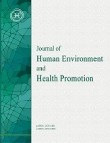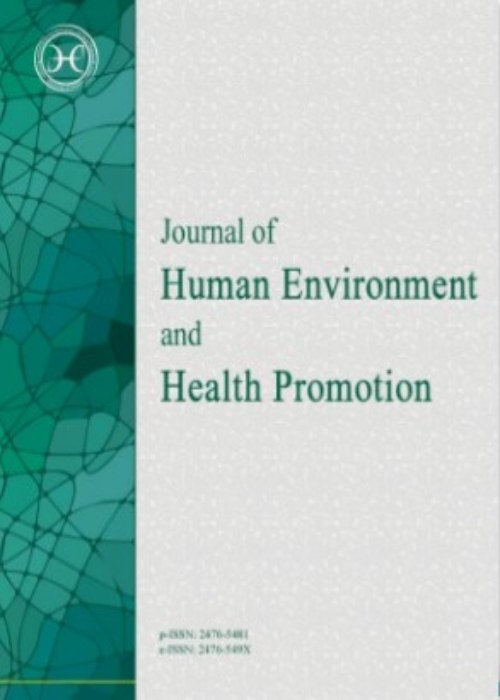فهرست مطالب

Journal of Human Environment and Health Promotion
Volume:9 Issue: 4, Autumn 2023
- تاریخ انتشار: 1402/09/06
- تعداد عناوین: 8
-
-
Pages 180-187
The COVID-19 pandemic resulted in significant effects on individuals involved in various aspects of the food supply chain, including production, processing, marketing, transportation, and consumption. Recent findings have demonstrated the survival rate of the virus on food surfaces is limited to hours and it can remain viable for several days in the optimum moisture and temperature. Consequently, health organizations in many countries have encouraged the public to heat food before consumption. Food safety specialists declared that heating food is a proper approach to significantly inactivate viruses. It has been recommended that meat products must not be eaten raw or undercooked. However, the increased emphasis on reheating food at home, driven by consumer concerns regarding food safety, has introduced a new set of challenges. It is estimated that this trend may lead to a higher intake of chemically hazardous substances, especially polycyclic aromatic hydrocarbons, due to the potential formation of heat-induced toxicants. Accordingly, this phenomenon is projected to have significant negative effects on public health during the post-pandemic phase of COVID-19. This paper aims to shed light on the changes in household food preparation habits following the widespread transmission of the virus, while also addressing the concerns surrounding food chemical safety that have arisen as a result of reheating practices during the COVID-19 pandemic.
Keywords: COVID-19, Coronavirus, Food safety, Polycyclic aromatic hydrocarbons, Heterocyclic aromatic amines, Acrylamide -
Pages 188-192Background
Identification of self-care behaviors and barriers in the COVID-19 pandemic can help health policymakers design appropriate and practical plans. This study aimed to investigate the efficacy of self-care behaviors in preventing COVID-19 based on the health belief model (HBM) among families in Yazd City.
MethodsThe present cross-sectional study was conducted using the convenience sampling method in 2020. The research data were collected via a researcher-made questionnaire based on the HBM. The validity and reliability of the questionnaire were confirmed before its distribution on social networks. A total of 226 questionnaires were collected and analyzed using SPSS software version 22.
ResultsThe results showed no significant correlations between the mean scores of HBM constructs and participants’ age, gender, and education level (p > 0.05). Also, the linear regression test indicated that perceived self-efficacy (B = 0.88), perceived susceptibility (B = 0.63), and perceived intensity (B = 0.74) were the most predictive constructs, demonstrating statistical significance. (P < 0/05). The HBM constructs could significantly predict preventive behaviors of COVID-19 and accounted for 29.6 % of their changes (Adjusted R2 = 0.296, F = 18.85, p ≤ 0.000).
ConclusionImplementing effective interventions based on the health belief model, with a particular focus on improving self-efficacy, perceived susceptibility, and perceived
Keywords: Self-care, Behavior, Prevention, control, COVID-19, Health Belief Model -
Pages 193-200Background
The purpose of this research is to investigate the concentration of heavy metals and nitrate in the fruit of pepper, eggplant, cucumber, and tomato cultivated in greenhouses in Kermanshah County.
MethodsAfter sample preparation and extraction, the concentration of heavy metals with an atomic absorption and nitrate (No3-) concentration were determined by a spectrophotometer at a wavelength of 410 nm. Subsequently, Human health risks were assessed using the Health Assessment Index of non-cancer diseases.
ResultsPepper exhibited elevated concentrations of nickel (Ni) and cadmium (Cd), while eggplant displayed higher levels of Ni, lead (Pb), and Cd. Cucumbers demonstrated an increased concentration of Cd, and tomatoes exhibited higher copper (Cu) and Cd levels, surpassing the standards set by the World Health Organization (WHO). A significant difference was observed between the studied vegetables and the concentration of heavy metals and nitrate. The highest daily intake rate and risk index of heavy metals and No3- were observed in eggplant and tomato.
ConclusionThe risk index of heavy metals was found to be below 0.1. However, the risk index for No3- exceeded 1. Therefore, it is recommended to study the potential sources of heavy metals contamination in the soil, water, and dust of the county to better understand the possible routes of food contamination.
Keywords: Daily intake rate, Greenhouse vegetables, Hazard index, No3- accumulation, Non-carcinogenic -
Pages 201-209Background
Physical activity during retirement is one of the health promotion determinants in this group. This study was conducted to determine the effect of an educational intervention based on the health action process approach (HAPA) on the levels of physical activity among retired female employees.
MethodsThis quasi-experimental study was conducted among 97 retired women, selected through a simple random sampling technique, and divided into two groups. The primary instruments employed for data collection included the International Standard Physical Activity Behavior Questionnaire (IPAQ) and a researcher-made questionnaire based on the HAPA. Data analysis was performed using SPSS version 20, incorporating a range of statistical tests, namely Spearman's correlation, independent and paired t-tests, the Willcoxon signed-rank test, and the Mann-Whitney U test.
ResultsAfter the educational intervention, the average score of different levels of physical activity has increased significantly (p < 0.05). In addition, three months after the intervention, the score of all the constructs of the HAPA model except for the structure of action planning and coping planning, was significantly increased (p < 0.05).
ConclusionThe implementation of an intervention based on the HAPA can improve the level of physical activity in middle-aged women. Therefore, it is suggested that future studies based on this approach be conducted in other target groups to promote physical activity.
Keywords: Health action process approach model (HAPA), Physical activity, Retirement, Social support, Self-efficacy -
Pages 210-215Background
The contamination of food with heavy metals is a significant concern for humans. Among food products, milk and dairy products have received more attention due to their widespread consumption at all ages, particularly among children. The aim of this study is to determine the concentration of lead and cadmium in milk and dairy products in Zanjan.
Methods132 samples of milk, doogh, yogurt, and cream were collected from Zanjan city during the winter and summer of 2020-2021. The lead and cadmium levels in the samples were quantified using microwave digestion and graffiti furnace atomic absorption spectrophotometry.
ResultsThe average concentrations of lead and cadmium in traditional milk, industrial milk, doogh, full-fat yogurt, low-fat yogurt, and cream samples were 96.23, 89.91, 78.79, 49.79, 53.74, 106.08, and 2.76, 2.07, 2.59, 1.09, 1.34, 5.60 µg/kg, respectively. The mean lead concentrations in milk and dairy products during winter were significantly higher than those during summer, whereas the mean cadmium concentrations during summer were higher than those during winter for all dairy products.
ConclusionThe lead and cadmium concentrations in most of the samples exceeded the WHO-FAO standards of 20 and 2.6 µg/kg for lead and cadmium, respectively. Therefore, prompt action is necessary to address this issue.
Keywords: Milk, dairy products, Lead, Cadmium, Zanjan, Heavy metal -
Pages 216-223Background
The family physician program plays a crucial role in promoting the quality of community‐based primary healthcare. This study aimed to explore the challenges and obstacles of implementing the family physician program in an Iranian urban community context.
MethodsA qualitative study design employing a conventional content analysis approach was conducted. The participants were nineteen healthcare recipients and healthcare providers from urban health centers in Bonab, Iran. Data were collected through semi-structured individual interviews until data saturation, and simultaneous data analysis was conducted. MAXQDA 10 software was used to manage the data. The study was conducted between February and July 2019 at the urban health centers in Bonab, Iran.
ResultsThe analysis of the collected data yielded three main categories, namely, ‘socio-cultural and economic challenges’, ‘interpersonal communication difficulties’, and ‘inefficient management’. These categories emerged as the challenges faced in implementing the urban family physician program in the community.
ConclusionThe implementation of the family physician program is a long process that is influenced by various factors and the elimination of barriers requires developing infrastructures and culture growth and improving the professional settings and interpersonal relationships.
Keywords: Family physician, Delivery of health care, Health services, Urban health services, Qualitative research -
Pages 224-228Background
This study aimed to evaluate microbial counts of beverage samples fermented using kombucha, including total acetic acid bacteria (AAB), total lactic acid bacteria (LAB), yeasts, and total microbial count (TMC).
MethodsA fermented orange beverage was produced using yogurt whey at three different concentrations (0 %, 10 %, and 20 % v/v) and kombucha at four different concentrations (1 %, 2 %, 3 %, and 4 % w/v) as the starter culture. Next, the microbial counts of the produced samples were evaluated at the end of the incubation and during cold storage at 4 ℃. The results were expressed as log CFU/mL.
ResultsThe results indicated a significant increase in the viability of AAB, TMC, and yeasts with increasing yogurt whey concentrations in the samples (p < 0.05). Furthermore, increasing the kombucha percentage in beverage samples resulted in the viability increment of TMC, AAB, LAB, and yeasts. Over time, the number of yeasts and viability of LAB increased in the samples. Moreover, the viability of TMC and AAB increased in the samples from days 7 to 10 and decreased from days 10 to 14 (p < 0.05).
ConclusionIncreasing yogurt whey and kombucha percentages affect microbial counts of beverage samples fermented using kombucha.
Keywords: Yogurt whey, Kombucha, Orange beverage, Acetic acid bacteria, Lactic acid bacteria -
Pages 229-234Background
The current study aimed to evaluate the effect of an alginate coating containing peppermint essential oil (PEO) and solid lipid nanoparticles (SLNs) against Salmonella Typhimurium and Escherichia coli O157: H7 inoculated on beef fillets and subsequently stored at a temperature of 4 ± 1 °C for 12 days.
MethodsBeef fillet samples were divided into four groups: CON group (without any coating solution), ALG group (coated with alginate solution), ALG + PEO group (coated with alginate solution containing 0.1 % (w/v) PEO), and ALG + SLN-PEO group (with alginate solution in combination SLN containing 0.1 % (w/v) PEO). The samples were then analyzed for the presence of inoculated E. coli O157: H7 and S. Typhimurium during refrigerated storage.
ResultsThe ALG + SLN-PEO coating had a larger impact in controlling the growth of pathogenic bacteria on beef fillets compared to the other treatment groups.
ConclusionAccording to the obtained results, the ALG + SLN-PEO coating could potentially be used in the food industry to reduce the risks associated with contamination of beef fillets by E. coli O157: H7 and S. Typhimurium.
Keywords: Alginate coating, Peppermint essential oil, Solid lipid nanoparticles, Beef fillet, Antimicrobial properties


